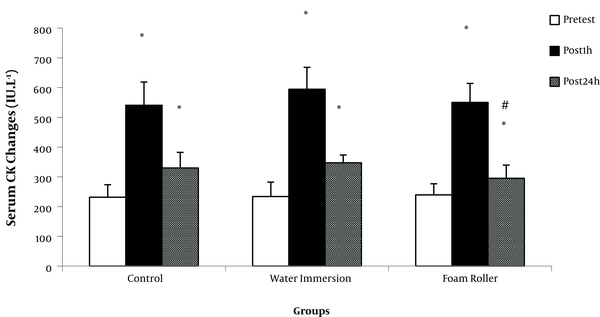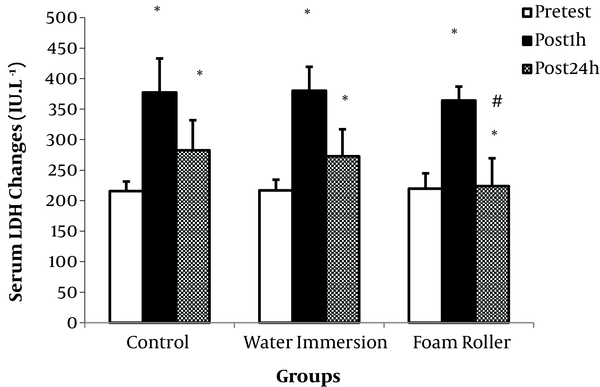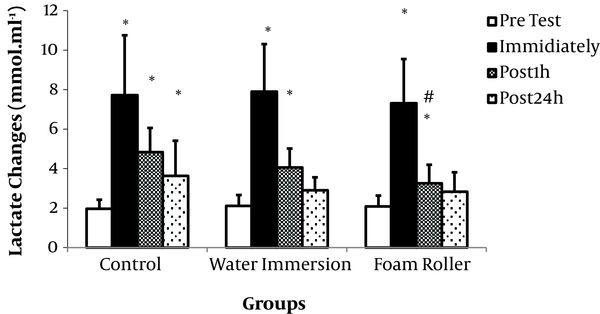1. Background
One of the indicators of returning to the original state is the amount of lactate excretion produced during a soccer match (1-3). Lactate accumulation disrupts many intramuscular metabolic processes, including the activity of phosphofructokinase, an allosteric enzyme in the glycolysis process, resulting in decreased ATP production and premature muscle fatigue. If the body still has high glycogen stores (4-6), using methods to harvest this product faster can have a profitable effect (7, 8). There are many methods for athletes to return to their original state (recovery), including stretching, massage, ice packs, anti-inflammatory drugs, antioxidants, active restoration, foam roller, immersion in contrasting water (alternating use of hot and cold water intermittently), immersion in hot water, and electrical stimulation (9).
The cold water immersion technique is one of the effective recovery methods used after competition and training. In this method, cold water causes the arteries to constrict and prevents inflammation, thus reducing creatine kinase output from the muscle (10). Also, immersion in cold water causes hydrostatic pressure on the body and makes the blood move from the lower parts of the body to the chest area during the float, which causes blood flow to expel substances from the metabolism faster (11). Immersion in cold water also reduces cell permeability through vasoconstriction, resulting in reduced inflammatory responses, muscle damage, edema, and pain. Since this method can help inflammation after intense and traumatic exercise as a treatment method, it may be a suitable way to reduce edema and inflammatory responses due to tissue damage (6, 12). In this regard, Muanjai et al. (2015) investigated the effect of stretching and immersion in cold water on functional symptoms, muscles, and perception of fatigue after 24, 48, 72, and 96 hours of training in three groups of stretching, immersion in cold water, and a combination of stretching and immersion. After a series of plyometric exhaustion exercises, they reported that immersion in cold water or stretching after exercise can be effective in maintaining flexibility, vertical jump performance, and reduced fatigue perception. While a combined method, as a suitable strategy to reduce the symptoms of muscle pain and maintain functional records, has not been proposed in this study (13).
On the other hand, Foam Roller (FR) is a new method, applicable for expanding recovery, which is based on the release of fibrous muscle fascia (14). This method helps relieve fatigue through a pseudo-massage technique by affecting several physiological processes, such as the ability to improve arterial function, improve vascular endothelial function, reduce muscle pain, and decrease the activity of the parasympathetic nervous system (15). During FR, people move the target muscles on a roller so that they put pressure on the soft tissue of the target muscles. With this operation, the Golgi tendon is stimulated, and muscle tension is reduced (16). Published studies indicate the effectiveness of recovery with FR in reducing muscle pain and improving performance in running speed, jumping, agility, muscle activation, and passive/dynamic range of motion compared to control conditions (17). Ray et al. (2017) investigated the effect of recovery with FR and passive recovery after a soccer match session in professional soccer players. The analysis results showed that the effect of recovery with FR was better than that of passive recovery on the rate of agility improvement and Delayed Muscle Onset Soreness (DMOS) 24 hours after training. Therefore, they concluded that 20-min recovery with FR was better than inactive recovery immediately after a competition or workout (18).
2. Objectives
Although several studies have been conducted on the effect of different recovery methods on various aspects of athletes' performance, there are still many ambiguities about the effectiveness of various post-soccer recovery strategies. Therefore, this study aimed to investigate the effects of active recovery methods on performance and muscle damage indices in young male soccer players after a simulated soccer match.
3. Methods
The statistical population included 30 young male soccer players. The criteria for entering the study included having at least two years of activity in the field of soccer, at least three to four sessions of training per week, and participating in all training sessions to measure research variables. Subjects who did not meet these conditions or did not participate in practice or variable measurement sessions, or those who were injured were excluded from the research process. Therefore, 21 male soccer players with an age range of 22-24 years who had at least two years of training were randomly selected. The characteristics of subjects including age, height, and weight are given in Table 1. To measure the variables of muscle damage in the pre-test and post-test stages, a 5-10-ml blood sample was taken from the right arm vein of each participant. The blood samples were centrifuged, and the isolated sera were stored at -80 °C. Serum levels of lactate dehydrogenase and creatine kinase were measured in three stages, including before, immediately, and 24 hours after the simulated soccer match using the ELISA technique. Blood lactate levels were also measured by sampling from the index finger of the right hand in four states, including before, immediately, one hour, and 24 hours after the simulated soccer match using a hp-cosmos lactometer (3, 11). The pain and muscle delayed onset soreness were measured in five stages, including before, immediately, one hour, 24, and 48 hours after simulated soccer match using the Visual Pain Scale (VAS) (13-15). Also, the YO-YO recovery test, Sargent jump test, 20-meter sprint test, and sit and reach test were used to measure the variables of aerobic power, explosive power, speed, and flexibility, respectively (13, 14, 19). The study was conducted based on Helsinki Declaration ethical standards in research and approved by the Ethics Committee of Kermanshah University of Medical Sciences with code IR.KUMS.REC.1398.689.
| Variables | Mean ± Standard Deviation |
|---|---|
| Age (years) | 16.95 ± 2.1 |
| Height (cm) | 175.29 ± 4.35 |
| Weight (kg) | 65.99 ± 5.76 |
| Body Mass Index (kg/m2) | 20.8 ± 1.3 |
| Body fat (%) | 13.6 ± 3 |
Demographic Characteristics of Subjects
3.1. Training and Recovery Protocol
The Bangsbo soccer-like protocol was simulated with the pattern of a soccer match. This protocol included two 45-min periods of intermittent activity similar to the patterns of professional players, in which the subjects first dribbled 50 meters with the ball and speed, followed by running the same path backward, running the course with a submaximal running intensity, running the second 25 meters at full speed, and slow recovery in the rest of the route to the starting line. The whole route had to be completed in two minutes for 25 times (19). Immediately after the simulated game, the subjects were randomly divided into three groups and performed one of the methods of cold immersion recovery, foam roller recovery, and passive recovery (control group) for 20 min. In the cold water immersion recovery method, the subjects were seated up to the neck for 20 min after playing the simulated game in a cold water pool with a temperature of 15 °C for 20 min (6, 12). Also, in the foam rolling recovery method, the subjects performed five different exercises using a foam roller. For this purpose, muscle groups (hamstrings, quadriceps, Gluteal muscles, Triceps surae muscle, abdominal muscles, and spinal straightening muscles) were targeted (14-16). In the passive recovery method, the subjects were placed on a chair for 20 min and did not perform any activity (7, 10).
3.2. Statistical Analysis
Descriptive statistics, such as mean and standard deviation, were used to analyze the data. Two-way ANOVA with repeated measures was used to assess within-group and between-group differences. The Tukey post hoc test was applied when the differences were significant. A 95% confidence interval was considered at all stages of the tests.
4. Results
The results of the two-way ANOVA test with repeated measures for the comparison of pre-test and post-test (time effect) showed that except for the performance variable of the 20-meter sprint (P value > 0.05), significant results were observed in the rest of the functional and physiological variables (P value < 0.05; Table 2). The results of one-way ANOVA showed that cold water immersion (P value = 0.024) and foam roller (P value = 0.014) recovery methods improved the flexibility of the subjects compared to the control group (P value < 0.05). However, in between-group comparisons by the Tukey post hoc test, no significant difference was observed between the two recovery methods (P value = 0.080; Table 2). There was no significant difference between the recovery groups in other physiological variables immediately and one hour after the simulated soccer game (P value > 0.05; Table 2). The results also showed that 24 hours after the simulated soccer game, significant differences were observed in the variables of creatinine kinase (Figure 1), lactate dehydrogenase (Figure 2), and delayed onset muscle soreness between active recovery groups and control (inactive) group (P value < 0.05; Table 2). The results also showed that there was a significant difference in creatine kinase levels between cold water and foam roller recovery methods 24 hours after the simulated soccer game, and this decrease was greater in the foam roller group than in the cold water recovery group (P value = 0.040; Figure 1). In addition, the results of one-way ANOVA showed that there was a significant difference only in the lactate variable one hour after the simulated soccer game, and the Tukey post hoc test showed that the foam rolling recovery method caused a significant decrease compared to the control group (P value = 0.011; Figure 3).
| Variables | Control | Water Immersion | Foam Rolling |
|---|---|---|---|
| VO2 max (ml.kg.min-1) | |||
| pretest | 48.3 ± 2.6 | 47.6 ± 2.5 | 47 ± 0.8 |
| posttest 48h | 47. ± 2.1b | 46.6 ± 2.3b | 46.2 ± 1.4b |
| Power (W) | |||
| pretest | 988.5 ± 98 | 1003.6 ± 130 | 989 ± 43 |
| posttest 24h | 998.5 ± 103 | 1114.8 ± 118 | 1018 ± 35b |
| Speed (sec) | |||
| pretest | 3.4 ± 0.29 | 3.41 ± 0.17 | 3.40 ± 0.14 |
| posttest 24h | 3.39 ± 0.3 | 3.30 ± 0.24 | 3.24 ± 0.19 |
| Flexibility (cm) | |||
| pretest | 41.1 ± 6 | 41.6 ± 6 | 41.5 ± 4 |
| posttest 24h | 41.6 ± 5 | 43.5 ± 5b,c | 48.8 ± 3b,c |
| CK (IU.L-1) | |||
| pretest | 231 ± 41 | 234 ± 48 | 239 ± 37 |
| posttest 1h | 540 ± 78b | 594 ± 73b | 550 ± 63b |
| posttest 24h | 329 ± 52b | 347 ± 26b | 294 ± 44b,c |
| LDH (IU.L-1) | |||
| pretest | 215 ± 15 | 216 ± 17 | 219 ± 25 |
| posttest 1h | 377 ± 55b | 380 ± 39b | 364 ± 22b |
| posttest 24h | 282 ± 49b | 272 ± 44b | 223 ± 45b,c |
| Lactate (mmol.ml-1) | |||
| pretest- | 1.96 ± 0.4 | 2.1 ± 0.5 | 2.1 ± 0.5 |
| immediately | 7.72 ± 3.02 b | 7.9 ± 2.4b | 7.3 ± 2.2b |
| posttest 1h | 4.8 ± 1.2b | 4.1 ± 0.9b | 3.2 ± 0.9b,c |
| posttest 24h | 3.63 ± 1.7b | 2.9 ± 0.6 | 2.8 ± 0.9 |
| DMOS (VS) | |||
| pretest | 0.6 ± 0.4 | 0.6 ± 0.2 | 0.7 ± 0.2 |
| immediately | 3.5 ± 1b | 3.6 ± 1.2b | 3.7 ± 1b |
| posttest 1h | 3.2 ± 0.8b | 3.1 ± 1.6b | 2.8 ± 1b |
| posttest 24h | 2.7 ± 1b | 1.5 ± 1.1b | 1.2 ± 0.6c |
| posttest 48h | 1.4 ± 0.5b | 1.2 ± 0.6 | 1.1 ± 0.7 |
Characteristics of Research Variables After Application of Recovery Protocolsa
5. Discussion
As the most important finding of the present study, the active foam rolling recovery method was a useful method to accelerate recovery in a similar way to active recovery by immersion in cold water after a simulated soccer game. The results showed that recovery using a foam roller improved performance and some indicators of muscle damage compared to other active and inactive recovery methods. The results of within-group comparisons showed that the amount of aerobic power decreased after applying different recovery protocols. Also, the amount of explosive power and flexibility increased after applying different recovery protocols, but the 20-meter speed was unchanged. The results of the present study are consistent with the results of Janker et al. (2015) and Ray et al. (2017) studies in terms of the effectiveness of active recovery methods in performance (14, 18). According to researchers, recovery by immersion in cold water causes the arteries to constrict and increases blood flow from the surface to the depth, leading to rapid excretion of waste products, thereby helping to quickly improve recovery. Also, the results of between-group comparisons showed that except for the flexibility variable, no difference was observed in other functional variables. The results showed that 48 hours after the application of recovery protocols, there was a significant difference between active and inactive recovery methods, and the greatest effect on the flexibility variable was related to the foam rolling recovery method. In support of these findings, Mardnik et al. (2017) and Janker et al. (2015) showed that the use of foam roller increased the range of motion and this recovery method helped improve flexibility by releasing the connective tissue fascia of the muscle, improving the function of arterial vessels and vascular endothelium, reducing sympathetic system activity, and stimulating the Golgi tendon organ (11, 14). Also, after the application of active and inactive recovery protocols, the indicators of muscle damage such as DMOS, lactate dehydrogenase, creatine kinase, and blood lactate showed significant differences in within-group comparisons. Besides, immediately, one hour, and 24 hours after the simulated soccer game, the levels of lactate, creatine kinase, lactate dehydrogenase, and DMOS showed significant increases compared to the pretest in all the three recovery groups. However, the foam rolling recovery group showed significant differences from the control group in the variables of creatine kinase, lactate dehydrogenase, and DMOS only 24 hours after the simulated soccer game, and at other times, the differences between the groups were not significant. In lactate values, this significant difference was reported in the foam rolling group one hour after the simulated soccer game. These results indicate that recovery time is an important factor in improving muscle injury and recovery indices. In support of these findings, in a study of the effects of foam rolling recovery on performance and DMOS, Pearcy et al. (2015) showed that recovery with a foam roller could improve performance and DMOS. The results of their research showed that the best time to reduce DMOS with a foam roller was 48 hours after the game, which is consistent with the results of our research. They also stated that foam rollers reduced DMOS by reducing edema, increasing lactate uptake, increasing blood flow to muscles, speeding up healing due to increased blood flow, reducing prostaglandin production, and reducing inflammation. One of the reasons for the time difference between the effectiveness of foam roller recovery and immersion in cold water in performance indicators and muscle damage can be found in research limitations. The limitations of the present study included the number of subjects, recovery time, and the number of recovery sessions. It seems that more research is needed to further investigate the effects of foam rolling recovery and compare it with cold water immersion recovery (15, 20).
In conclusion, the results suggest that foam rolling recovery can be faster than cold water immersion recovery and can be a beneficial way to accelerate recovery by reducing edema, increasing lactate uptake due to increased blood flow to muscles, increasing the speed of healing due to increased blood flow, reducing the production of prostaglandins, and reducing inflammation and DMOS.



